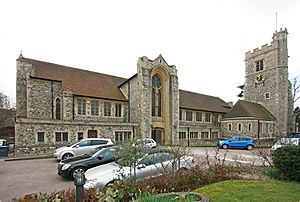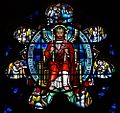St Peter and St Paul, Bromley facts for kids
Quick facts for kids St Peter and St Paul, Bromley |
|
|---|---|
| Bromley Parish Church | |
 |
|
| 51°24′18″N 0°00′47″E / 51.4050°N 0.0131°E | |
| Location | Church Road, Bromley, Kent BR2 0EG |
| Country | England |
| Denomination | Church of England |
| Website | bromleyparishchurch.org |
| History | |
| Dedicated | 1957 |
| Architecture | |
| Architect(s) | J. Harold Gibbons |
| Years built | 1949 |
| Administration | |
| Parish | Bromley |
| Deanery | Bromley |
| Archdeaconry | Bromley and Bexley |
| Diocese | Rochester |
St Peter and St Paul, also known as Bromley Parish Church, is a historic church located in the town of Bromley in south east London. It is part of the Church of England and belongs to the Diocese of Rochester. The church is easy to find, being close to Bromley High Street and between the Bromley North and Bromley South train stations.
This church has a fascinating history. It was mostly destroyed during the Second World War by bombs. However, it was lovingly rebuilt in the 1950s. Since 1955, it has been recognized as a Grade II* listed building, which means it's a very important historical site.
Contents
History of Bromley Parish Church
The Old Church Building
Before the Second World War, the church looked very different. It was built in a style called Perpendicular Gothic. This style often features tall windows and strong, straight lines. The old church had a square tower with battlements, which are like the tops of castle walls.
In 1792, the north side of the church was rebuilt. Then, in 1830, the whole church was made new and bigger. Sadly, on April 16, 1941, a bomb hit the church. Almost all of it was destroyed, except for the strong tower.
Building the New Church
After the war, it was time to rebuild. On October 13, 1949, a very special person laid the foundation stone for the new church. This was Princess Elizabeth, who later became Queen Elizabeth II.
It took eight more years to finish the rebuilding work. On December 14, 1957, the new church was officially opened. The Bishop of Rochester, Christopher Maude Chavasse, led the special ceremony. The church today still includes parts of the old medieval tower. It also uses many of the original flint stones and other pieces from the first building.
Interesting Features of the Church
Beautiful Stained Glass Windows
When you visit the church, you'll see many beautiful stained glass windows. Several of these were designed by an artist named M. E. Aldrich Rope. She was known for her work in the Arts and Crafts Movement, which focused on handmade items and traditional skills.
One of her students, Clare Dawson, designed the window in the Baptistery. This is the area where baptisms take place.
The Church Organ
The organ at St Peter and St Paul is a very impressive musical instrument. It was built in 1991 by a company called J. W. Walker & Sons Ltd. This organ was designed to do three main things:
- Help people sing during church services.
- Play music for the church choir.
- Be used for concerts, either by itself or with other instruments.
The organ is quite large, with three keyboards and pedals. It has 40 different sounds, called "speaking stops." It also has 2,708 pipes and weighs about 12 tons! The organ was first put together in the workshop, then taken apart and moved to the church. The wooden cases and carved decorations around the pipes were designed by David Graebe.
Important Tombs and Memorials
Many famous people have been buried at St Peter and St Paul over the years. Some of them include:
- John Yonge or Young, who was a bishop of Rochester.
- Elizabeth Johnson, the wife of the famous writer Samuel Johnson. Her memorial was saved after the Second World War bombing and put back in the rebuilt church. Samuel Johnson visited the church in 1753 to say goodbye to her.
- John Hawkesworth, a writer and editor who was also a friend of Samuel Johnson.
- Zachary Pearce, another bishop of Rochester.
- John Gifford, a British writer who supported a politician named William Pitt the Younger.
- Sir Claude and Sir Edward Scott, who were important members of the Scott family.
Gallery
See also












